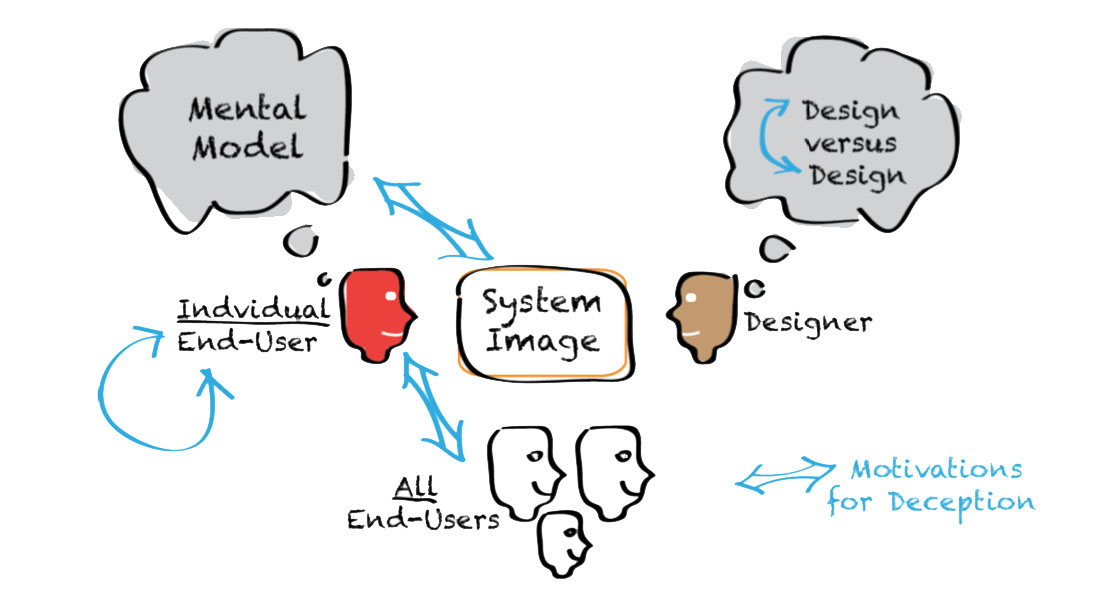Users generally trust computer interfaces to accurately re- T system state. Reflecting that
state dishonestly— through deception—is viewed negatively by users, rejected by
designers, and largely ignored in HCI research. Many believe outright deception should
not exist in good design. For example, many design guidelines assert: “Do not lie to
your users” (e.g., [40, 45]) Misleading interfaces are usually attributed to bugs or poor
design. However, in reality, de- ceit often occurs both in practice and in research. We
con- tend that deception often helps rather than harms the user, a form we term
benevolent deception. However, the over- loading of “deception” as entirely negative
coupled with the lack of research on the topic, makes the application of de- ception as a
design pattern problematic and ad hoc.

plored features that enable this type of deception. While research into human-to-human
deception has advanced our understanding of deception in general, it has largely focused
on communication behavior that pre-exists, and per- sists through, computermediated-communication.
Most of the systematic research in the academic HCI com- munity focuses on
malevolent deception, or deception in- tended to benefit the system owner at the
expense of the user [14]. Such research frames deception negatively, and focuses on
detection and eradication of malicious or evil interfaces (e.g., dark-patterns [17]). Such
patterns include ethically dubious techniques of using purposefully confus- ing
language to encourage the addition of items to a shop- ping cart or hiding unsubscribe
functionality. Many forms of malevolent deception, such as phishing and other fraud, is
in clear violation of criminal law.
Deceptive practices that are considered harmful by legal organizations are, for
generally good reasons, considered harmful by designers as well. A possible exception
to the negative frame for malevolent deception is in contexts where an obvious
adversary exists or for military or securi- ty purposes. For example, to detect network
attacks or illicit use, security researchers may deploy “honeypots” to imitate vulnerable
plored features that enable this type of deception. While research into human-to-human
deception hcceptable even when it might affect legitimate clients who try to connect
even though no services are available.
It can be difficult to draw the line between malevolent and benevolent deception. We
frame the distinction from the end-user’s perspective: if the end-user would prefer an
ex- perience based on the deceptive interface over the experi- ence based on the
“honest” one, we consider the deception benevolent. Note that this includes situations
in which both the system designer and the end-user benefit from the de- ception,
something economists sometimes term a Pareto white lie [19]. Arguably, all benevolent
deceptions that im- prove user experience benefit the interface creator as well;
otherwise, we might use the term altruistic deception [19].
The limited HCI research that has been conducted on be- nevolent deception has
focused on the use of magic [54], cinema and theater [32] as instructional metaphors for
HCI design. By using deception for the purpose of entertain- ment, playfulness, and
delight, it becomes acceptable. This work has connected these art forms, in which
illusion, im- mersion, and the drive to shape reality dominate, to situa- tions in which
there is willing suspension of disbelief on the part of the user, or at least willing pursuit
of acceptable mental models. Similar lessons have been drawn from ar- chitecture. For
example, theme parks and casinos [20, 34, 37] are designed specifically to utilize
illusions that manip- ulate users’ perception of reality, entertainment, and partic- ipation
in the experience. In this paper, we will describe a number of deceits in HCI systems
that have parallel designs to magic, theater, and architecture. However, not all benevolent
deceit can be framed in terms of creating delight for
as advanced our understanding of deception in general, it has largely fo- cused on
communication behavior that pre-exists, and per- sists through, computer-mediatedcommunication.
Most of the systematic